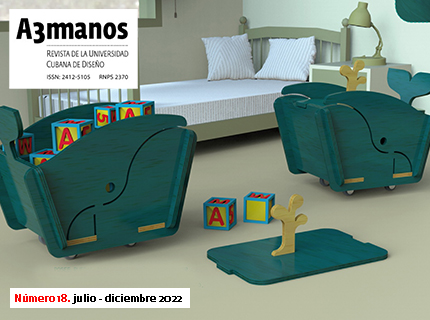El código como medio creativo para la formación variable en Diseño Gráfico.
##plugins.themes.bootstrap3.article.main##
Resumen
Hoy en día, gran parte del diseño gráfico que encontramos se crea, distribuye y experimenta a través de medios informáticos. Los diseñadores pueden usar computadoras más allá del software estándar, particularmente para escribir su propio software. Sin embargo, la investigación sobre el código, un medio computacional en bruto para dar formas generativas, aún está ausente en gran medida en el contexto del diseño gráfico (Bartlett y Tatum 2020; Shim 2020; Shim 2021). El ensayo de este profesional incluye una revisión de la literatura y un examen del trabajo de diseño gráfico relacionado para establecer los antecedentes contextuales de los enfoques computacionales en el diseño gráfico, en particular aquellos que definen la programación como material y proceso para diseñar sistemas generativos. Los ejemplos de tales sistemas generativos en el trabajo de este profesional producen variaciones visuales manipuladas algorítmica y paramétricamente que son dinámicas para la entrada del usuario, las fuentes de datos externas y la aleatoriedad. La clave para adoptar un enfoque computacional en el diseño gráfico y generar "formaciones variables", o el proceso de construcción de sistemas generativos que emergen formas dinámicas utilizando código y datos, es comprender y aplicar el código como un medio creativo. Como tal, este ensayo reflexivo demuestra cómo se utiliza la computación como medio de diseño gráfico para crear variabilidad en la apariencia y el comportamiento de las formas visuales.Today, much of the graphic design we encounter is created, distributed, and experienced through computational media. Designers can use computers beyond standard software, particularly for writing their own software. However, research on code––a raw computational medium for generative form-giving––is yet largely absent within the context of graphic design (Bartlett and Tatum 2020; Shim 2020; Shim 2021). This practitioner’s essay includes a literature review and an examination of related graphic design work to establish the contextual background of computational approaches in graphic design, particularly those that define programming as both material and process for designing generative systems. Examples of such generative systems in this practitioner’s work produce algorithmically and parametrically manipulated visual variations that are dynamic to user input, external data sources and randomness. Key to taking a computational approach in graphic design and generating ‘variable formations’, or the process of building generative systems that emerge dynamic forms using code and data, is understanding and applying code as a creative medium. As such, this reflective essay demonstrates how computation is used as a graphic design medium to create variability in the appearance and behavior of visual forms.
##plugins.themes.bootstrap3.article.details##

Esta obra está bajo una licencia internacional Creative Commons Atribución-NoComercial-CompartirIgual 4.0.
- Atribución — Usted debe dar crédito de manera adecuada , brindar un enlace a la licencia, e indicar si se han realizado cambios . Puede hacerlo en cualquier forma razonable, pero no de forma tal que sugiera que usted o su uso tienen el apoyo de la licenciante.
- NoComercial — Usted no puede hacer uso del material con propósitos comerciales .
- No hay restricciones adicionales — No puede aplicar términos legales ni medidas tecnológicas que restrinjan legalmente a otras a hacer cualquier uso permitido por la licencia.
- CompartirIgual — Si remezcla, transforma o crea a partir del material, debe distribuir su contribución bajo la misma licencia del original. NOTA: Este punto aplica para los números 1 al 20 de la revista con la anterior licencia CC-BY-NC-SA 4.0. No aplica para la nueva licencia CC BY-NC 4.0 desde el Volumen 11, Número. 21 (2024).
Citas
Bartlett B, and Tatum R (2020) The Generative Typographic Brand. Hoffmitz Milken
Center for Typography: DETI. Available at:
https://www.youtube.com/watch?v=MAlhBMqi-QU
(accessed 28 February 2022)
Blauvelt A (2011) Tool (Or, Post-production for the Graphic Designer). In: E. Lupton and
A.
Brownie B (2015) Transforming Type. London and New York: Bloomsbury Academic
Cho P (1999) Computational models for expressive dimensional typography. MS thesis,
Massachusetts Institute of Technology, Program in Media Arts & Sciences.
Fry B (2004) Computational Information Design. PhD dissertation, Massachusetts
Institute of Technology, Program in Media Arts & Sciences.
Gerstner K (2007) Designing Programmes: Programme as
Typeface, Typography, Picture, Method. Baden: Lars Müller Publishers.
Hillner M (2007) Basics Typography 01: Virtual Typography. Lausanne: AVA Publishing.
Giampietro R, Jen N, Krishnamurthy P, and Van Blokland P (2013) Type is Never the
Thing Itself. The Type Directors Club: Archive. Available at:
https://archive.tdc.org/news/type-is-never-the-thing-itself-generative-typography-video/
(accessed 28 February 2022)
Küsters C and King E (2001). Restart: New Systems in Graphic Design. London:
Thames & Hudson.
Maeda J (1999) Design by Numbers. Cambridge: The MIT Press.
Manovich L (2013). Software Takes Command. London and New York: Bloomsbury
Academic.
MuirMcNeil (2016) Interview: MuirMcNeil. In: K. Shim (ed.) GRAPHIC, 37, pp.121–132.
Schön DA and Wiggins G (1992) Kinds of seeing and their functions in designing.
Design
Studies 13(2): pp. 135–156.
Shim (2020) Computational Approach to Graphic Design, The International Journal of
Visual Design, 14(1). Chicago: Common Ground Research Networks.
Shim (2021) The Future of Typography through the Lens of Computational Design, in
Kim, M. (ed.), Typography in the Digital Age. Seoul: Hongdesign.
Small D (1999) Rethinking the Book. PhD dissertation, Massachusetts Institute of
Technology, Program in Media Arts & Sciences.
Small D, Ishizaki S, and Cooper M (1994) Typographic Space. Conference Companion
on Human Factors in Computing Systems. New York: ACM, pp.437–438.
























